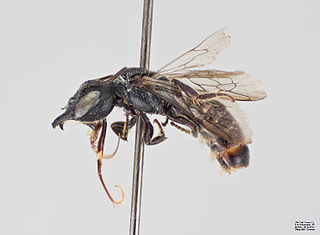
Megachilidae is a cosmopolitan family of mostly solitary bees. Characteristic traits of this family are the restriction of their pollen-carrying structure to the ventral surface of the abdomen, and their typically elongated labrum. Megachilid genera are most commonly known as mason bees and leafcutter bees, reflecting the materials from which they build their nest cells ; a few collect plant or animal hairs and fibers, and are called carder bees, while others use plant resins in nest construction and are correspondingly called resin bees. All species feed on nectar and pollen, but a few are kleptoparasites, feeding on pollen collected by other megachilid bees. Parasitic species do not possess scopae. The motion of Megachilidae in the reproductive structures of flowers is energetic and swimming-like; this agitation releases large amounts of pollen.

Mason bee is a name now commonly used for species of bees in the genus Osmia, of the family Megachilidae. Mason bees are named for their habit of using mud or other "masonry" products in constructing their nests, which are made in naturally occurring gaps such as between cracks in stones or other small dark cavities. When available, some species preferentially use hollow stems or holes in wood made by wood-boring insects.

Heriades is a genus of bees in the family Megachilidae. Fairly small and usually black, they are found all over the world. There are more than 130 species worldwide, roughly 25 species in North and Central America, but only 3 species are native east of the Rocky Mountains. European species such as H. truncorum can be found on the east coast of the US. Like other bees in the tribe Osmiini, Hoplitis and Ashmeadiella, they nest in cavities in wood excavated by other insects, or perhaps occasionally pine cones. They separate the cells of their nest with resin .

Hoplitis anthocopoides is a species in the family Megachilidae, in the order Hymenoptera . The distribution range of Hoplitis anthocopoides includes Africa, Europe, Northern Asia, and North America.

Osmiini is a tribe of leafcutter, mason, and resin bees in the family Megachilidae. There are about 19 genera and at least 1,000 described species in Osmiini.
Hoplitis bunocephala is a species of bee in the family Megachilidae. It is found in North America.

Hoplitis is a genus of bees in the family Megachilidae. There are more than 380 described species in Hoplitis.
Chelostoma californicum is a species of bee in the family Megachilidae. It is found in Central America and North America.
Hoplitis producta is a species of bee in the family Megachilidae.
Hoplitis incanescens is a species of bee in the family Megachilidae. It is found in North America.

Hoplitis fulgida is a species of bee in the family Megachilidae. It is found in North America.
Hoplitis biscutellae is a species of bee in the family Megachilidae. It is found in Central America and North America.
Hoplitis bullifacies is a species of bee in the family Megachilidae. It is found in North America.
Osmia clarescens is a species of bee in the family Megachilidae. It is found in Central America and North America.

Protosmia rubifloris is a species of bee in the family Megachilidae. It is found in Central America and North America.

Osmia integra is a species of bee in the family Megachilidae. It is found in North America. It forms shallow nests in sand dunes.

Chelostoma rapunculi is a species of bee in the family Megachilidae. It is found in Europe and Northern Asia and North America.
Osmia longula is a species of bee in the family Megachilidae. It is found in North America.
Trachusa cordaticeps is a species of bee in the family Megachilidae. It is found in Central America and North America.

Hoplitis tuberculata, also known as the Lundwood bee, is a species of solitary bee belonging to the family Megachilidae. Hoplitis tuberculata exhibits a disjunct distribution range, with its habitat spanning the subalpine zones of the Alps and extending to boreal regions in Europe and Asia. The species primarily nests in insect borings in dead wood and utilizes various materials for constructing its brood cells.










